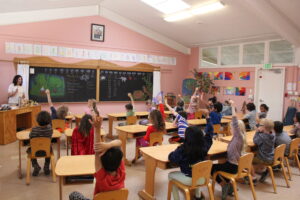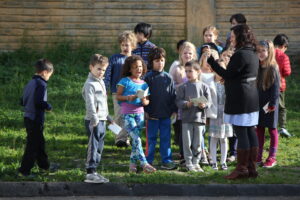
Why Does a Waldorf Class Teacher Traditionally Stay with their Class in Grades One through Eight?
by Catherine Dwyer | WSP Class Teacher
Years ago when I first taught elementary school, before I met Waldorf education, every year I would have a new group of students and I would spend the first few months getting to know them as they got to know me. As the months progressed, I would increase my understanding of how each child learned best. We would have a few months of solid learning and then, poof, it was summer, and the students would move on. In the fall, I would get another group of new students and we would start all over again. It was the same every year – just as you really got to know the students, the year was over. It was sad. Although switching to new teachers every year seemed normal to me then, in retrospect, there was a lot of time spent figuring out the best way to teach each child in your new class.
 One of many unique aspects of Waldorf education is that the class teacher traditionally stays with their class from grades one through eight. Parents sometimes ask why this is the tradition at Waldorf schools. Rudolf Steiner, the founder of Waldorf education, made this recommendation over a hundred years ago, stating that children benefit when they remain with their teacher, versus switching to a new teacher each year. Now, (as often happens with Waldorf’s unique practices), science has caught up with Steiner and recent research shows benefits, such as higher academic performance and improved school experience, for students who stay with the same class teacher (often called looping).
One of many unique aspects of Waldorf education is that the class teacher traditionally stays with their class from grades one through eight. Parents sometimes ask why this is the tradition at Waldorf schools. Rudolf Steiner, the founder of Waldorf education, made this recommendation over a hundred years ago, stating that children benefit when they remain with their teacher, versus switching to a new teacher each year. Now, (as often happens with Waldorf’s unique practices), science has caught up with Steiner and recent research shows benefits, such as higher academic performance and improved school experience, for students who stay with the same class teacher (often called looping).
One big benefit that research has shown with looping: when students return in the fall with the same teacher, the class doesn’t need to spend a lot of learning time getting to know each other. Successful learning can start right away because the teacher already knows how each student learns. And this ease with a familiar teacher creates a comfortable beginning for each returning student, too. Surprisingly, coming into a class where the teacher and students have been together longer positively impacts the learning of any new students as well.
We knew that if the teacher had more time with students, we could see some gains,” says Linda DeBerry, the principal at Dyersburg, which covers pre-kindergarten through second grade. Students in their second year with the same teacher typically learn over one-third more content than students in the same grade who had different teachers, DeBerry says. “We see evidence of this in all grades.” Principal DeBerry started looping teachers 15 years ago after noticing benefits when looping happened accidentally. “What we see is those teachers know exactly what student strengths and weaknesses are. At the beginning of the year, they don’t have to figure that out,” she says. “For students who don’t develop as fast, teachers have longer with them to reach goals.”
The reason, researchers conclude, is that longer relationships make both teaching and learning easier and improve student behavior. Looping with students, even if it doesn’t take place in sequential years, can be more efficient, says John Papay, associate professor of education and economics at Brown University’s Annenberg Institute. Papay, another lead researcher on the Tennessee study, cites the time teachers spend getting to know students at the beginning of the school year. “There’s an upfront cost – learning names, talking about goals, getting to know families,” he says. “If you have students a second year, you don’t have to do that. There’s less diagnostic work.”
Interestingly, Papay notes, the Tennessee study didn’t just find academic and behavioral benefits for students who had the same teacher for multiple years. There is a “spillover” effect during the second year of a looped classroom for students who are having the teacher for the first time. Students who are new to a teacher in a class where half of the students have had the teacher before also do better academically, have better attendance and fewer behavioral issues than they did in other teachers’ classrooms.” The Benefits of Teacher Looping – USNews by Kate Rix (February 2023).
Steiner discussed many benefits of the teacher and students staying together. One of them is that the teacher comes to know the student very well and can support their growth in the best way. The teacher can respond more readily to the students as they grow, with knowledge of where they were previously in their development and how they are progressing. The child feels the teacher’s care and attention. This warmth between the teacher and the child creates the perfect environment for learning, with trust and comfort born from many years together. From this safe place, the imagination can soar. The teacher can follow the child’s interests. Wonder, for the world and all its mysteries, leads to deep thinking, learning, and exploring new ideas.
Steiner also mentioned the benefit of that the teacher can bring the learning subjects for each year and deepen them based on what was taught previously – teachers can teach effectively and efficiently because they know what they’ve brought before and where the children might need more. The teacher can also plan for future learning, bringing touches of subjects to the children in the younger grades to plant seeds for a future grade’s work. For example, the teacher may tell a story about sunflowers in grade one, and plant sunflowers in grade three during farming, because the teacher plans to study the sunflower when the students cover botany in grade five.
He also stressed that the teacher always staying an active learner with the students. With a new grade each year, the teacher is learning new material, too. They can bring their own wonder to each new lesson. The teacher can model learning behavior for the students. The material is fresh for the teacher, so it is fresh for the students. Steiner believed that the students learn much from the teacher’s own striving. The students are invigorated in beholding their teacher as a learner and sharing in the process together. (Steiner)
Research supporting Steiner’s indications is growing:
“The advantages of looping are intertwined for teachers, students, and families. These can be categorized in three broad areas: (1) time, (2) relationships, and (3) student support and engagement. By its very nature, looping provides additional time, which, in turn, enhances instruction and assessment. Relationships—teacher/team-to-student, student-to-student, teacher/team-to-parent—benefit from the stability afforded by looping.
Finally, engagement among teachers, students, and parents increases and fosters the social development of students due to the multiyear investment. George and Lounsbury (2000) and George and Shewey (1997) found that participants invested in long-term teacher-student relationships (i.e., looping) agreed that a greater sense of community developed as a result. Teacher-student rapport is recognized as a vital component of an effective classroom (Montalvo, Mansfield, & Miller, 2007; Westerfield, 2009).” Looping – Association of Middle Level Education by Thompson, N. L., Franz, D. P., & Miller, N. (November 2009).
 Another wonderful benefit when a teacher stays with the class is the strong community that is built with the parents, students, and teacher. The students and parents know the class teacher and the subject teachers well. The parents also know the children and each other well. Each year spent together builds their community. This strong team of teachers and parents together support and hold the class, encouraging each child’s growth and well-being.
Another wonderful benefit when a teacher stays with the class is the strong community that is built with the parents, students, and teacher. The students and parents know the class teacher and the subject teachers well. The parents also know the children and each other well. Each year spent together builds their community. This strong team of teachers and parents together support and hold the class, encouraging each child’s growth and well-being.
“Better rapport between parents and teachers can result in more active parent involvement and therefore higher levels of student achievement. The context of looping results in improved relationships among teachers, students and parents, and an increase in satisfaction is experienced by most participants (Cistone & Shneyderman; Elliot & Capp, 2003; Forsten, Grant, & Richardson, 1999; Simel, 1998). The investment of time, cultivation of relationships, and prolonged engagement associated with looping, promote an academic environment in which most people flourish.” Looping – Association of Middle Level Education by Thompson, N. L., Franz, D. P., & Miller, N. (November 2009).

First grade teacher and children outdoors
A Waldorf first grade classroom is a magical place. The teacher stands before the students, ready to take them on an adventure. The students look up with adoration, ready and eager to follow. The shared warmth of the first joyful years together helps the class weather the sometimes bumpy nine-year-change. Every year the students return to a familiar social circle of classmates, surrounded by teachers who know and care for them. Their class teacher holds the students with thoughtful care and attention. The affection within the class helps them ride the wave of adolescent puberty together, through their differing spurts of growth and maturity. With their teacher’s support, they keep steady with the goal of respect and kindness for each other, as they pursue ever more expanding topics, teaching each other with their different perspectives in ever deepening discussions of life and knowledge in all their messy glory.
And suddenly, the students are in eighth grade. The class is solid together; the classmates support each other. When it counts, they are there for each other. And they are having fun. They are ready to go on together, to continue learning with each other. Now, their class teacher can step back and let them go on their next adventure – the complete wonder and even deeper thinking in high school, surrounded in support and warmth again, but this time with an extensive team of enthusiastic high school teachers who are ready to meet the world with them.

Photos of Mrs. Waheed and her class from first to eighth grades, from 2014 to earlier this month in 2023.
References
Rix, Kate. “The Benefits of Teacher Looping | K-12 Schools | U.S. News.” The Benefits of Teacher Looping, 24 Feb. 2023, www.usnews.com/education/k12/articles/the-benefits-of-teacher-looping.
Steiner, Rudolf. Discussions with Teachers: Fifteen Discussions with the Teachers of the Waldorf School in Stuttgart, August 21st to September 6th, 1919 ; Translated by Helen Fox. Rudolf Steiner Press, 1992.
Thompson, N. L., Franz, D. P., & Miller, N. (2009). Research summary: Looping. Retrieved 25 May 2023, from http://www.amle.org/TabId/198/ArtMID/696/ArticleID/311/Research-Summary-Looping.aspx.
